Non-accelerator Group
CANDLES experiments
The CANDLES experiment aims to perform the world's most sensitive measurement of neutrino mass by studying 48Ca.
Double beta decay
“Double beta decay” is a phenomenon in which two neutrons in an atomic nucleus are converted into two electrons and two protons. Two anti-neutrinos are also emitted at this time.This “two neutrino double beta decay” process is allowed within the standard model of particle physics, although the decay rate is extremely small. On the other hand, there is also the other process of double beta decay in which the emitted anti-neutrinos are converted to neutrinos inside the atomic nucleus and are absorbed, and as a result no neutrinos are emitted. This "neutrinoless double beta decay" is not permitted by standard model of particle theory, and requires the new physics beyond it.
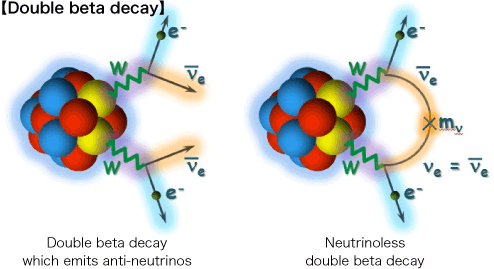
Importance of neutrinoless double beta decay
Majorana nature of neutrinos
Neutrinoless double beta decay occurs when the neutrinos are Majorana particles. In other words, if this decay can be observed, this would prove that the neutrinos are Majorana particles, and that itself is a remarkable discovery. This would provide support for the neutrino see-saw mechanism, which naturally explain why neutrinos have such little mass compared to other fundamental particles.
Majorana particles
Ordinarily particles which compose matter have a corresponding anti-particles and are known as Dirac particles. In particular for a particle with a charge, there must exist an anti-particle with the opposite charge. It has been suggested that among particles with no charge, there may exist a particle (known as a Majorana particle) where there is no difference between the particle and its anti-particle. Among particles with mass, it is possible that, only uncharged neutrinos are Majorana particles. Whether neutrinos are Majorana particles or Dirac particles remains a big question even today. The theory of the see-saw mechanism naturally explains why neutrinos have such little mass compared to other fundamental particles, however it is based on the assumption that neutrinos are Majorana particles.
Violations of lepton number (particle number) conservation
Neutrino-less double beta decay does not conserve the lepton number before and after the decay (a violation of lepton number conservation). This lepton number violating process is an important step toward explaining the mystery of why our universe is composed only of matter with all the antimatter having disappeared.
Neutrino mass and mass hierarchy
Finally, if the half-life of neutrinoless double beta decay can be measured, it will be possible to derive an absolute value for neutrino mass from the formula which describes the relationship between half-life and neutrino mass. The Super-Kamiokande experiment and other neutrino oscillation experiments have shown that neutrinos do have mass, and hence that there are mass differences between the different types of neutrinos. However the absolute mass of a neutrino has not yet been measured. If the absolute value of neutrino mass can be measured, then it will be possible to identify the neutrino mass hierarchy.
Principle for measurement of neutrinoless double beta decay
Double beta decay is a phenomenon in which two neutrons in the atomic nucleus are converted to two protons and emit two beta rays (electron), increasing the atomic number of the nucleus by 2. The released energy at this time (Q value) is given by the mass difference of the nucleus before and after the decay.
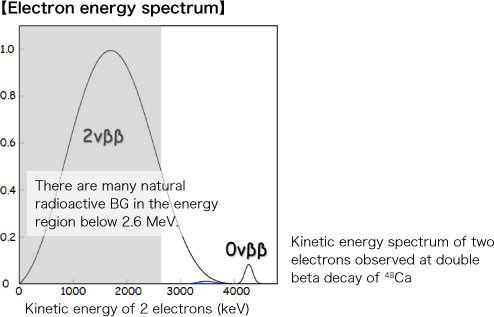
As shown in the figure, when two anti-neutrinos are emitted, a portion of the released energy is carried away by the neutrinos. As a result, the sum of the kinetic energy of the two electrons is distributed continuously (a continuous spectrum). However with neutrinoless double beta decay, because no energy is carried away by the neutrinos, the sum of the electron kinetic energy matches the Q value and is constant (a monochromatic spectrum).
In this way, we can observe neutrinoless double beta decay by measuring the sum of the kinetic energy of the two electrons.
The probability of “neutrinoless double beta decay” is thought to be even smaller than that of the “two neutrino double beta decay.” Therefore steps such as reducing detector background as much as possible are necessary in order to observe it.
CANDLES experiment
Because “neutrinoless double beta decay” is an extremely rare phenomenon, the following two points are important for observing it.
●Prepare a large amount of double beta decay nuclei.
●Measure in low background condition.
It is not easy to satisfy these both at the same time. This is because measurement systems which use large amounts of double beta decay nuclei involve an increase in background that is proportional to the increase in size. Therefore a low background measurement system was developed for the CANDLES experiment. In addition, the project calls for the use of concentrated double beta decay nuclei, which will increase the double beta decay nuclei without increasing the size of the measurement system.
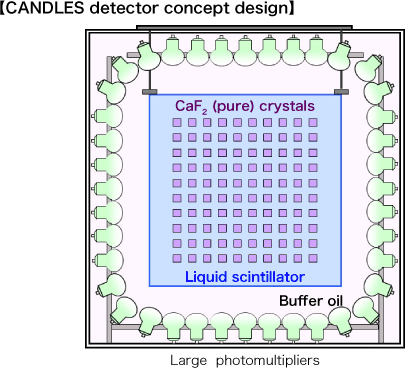
Characteristics of the CANDLES detector
48Ca as double beta decay isotope
Among the large numbers of double beta decay isotopes, the CANDLES project has selected the 48Ca isotope for use. The sum of the kinetic energy of the two electrons emitted by neutrino-less double beta decay of 48Ca is 4.27 MeV, the largest Q value. Because this Q value is higher than the environmental radiation (γ rays), it has the advantage of being easier to perform low-background condition. Specifically, there is the 2.6 MeV γ ray that is emitted by 208Tl beta decay of 208Tl → 208Pb. This is a high energy γ ray that is frequently observed in the natural environment. The background condition changes significantly depending on whether the Q value is larger or smaller than this value.
However a serious problem was the natural abundance of 48Ca is extremely small, at just 0.187%, and that a method for efficiently concentrating Ca isotopes was unknown. Because a large quantity of the beta decay nuclei is required, 48Ca was not considered a suitable isotope for observation of double beta decay. However with the CANDLES project, this problem was resolved by using a structure which easily permits large sizes in the detector design, and by preparing a large amount of natural Ca isotopes.
At the same time, because the abundance ratio of the 48Ca isotope is low, there is the potential for dramatically improving the sensitivity if it is possible to concentrate the isotope. The CANDLES project is proceeding with research and development of methods for the difficult process of concentrating the 48Ca isotope, aiming to achieve this isotope concentration for future projects.
CaF2 scintillator crystals
The CANDLES detector measures double beta decay using calcium fluoride (CaF2) crystals that contain 48Ca. These crystals act as a scintillator that emits UV-band scintillation light by the energy deposit of radiation. If neutrinoless double beta decay occurs, the kinetic energy of the electron rays is converted to scintillation light in the CaF2 crystals, and this energy can be measured by observing the light.
Because CaF2 crystals are commonly used in camera lenses and other commercial applications, crystals with high transparency and high purity have been developed. Because of the high transparency (light attenuation length of 10m or more), the scintillation light is not attenuated even when the size of the detector is large, allowing accurate energy information to be acquired. Because of the high purity (small amount of impurities in the crystals), it is possible to produce crystals that include extremely small amounts of the radioactive impurities which cause background radiation.
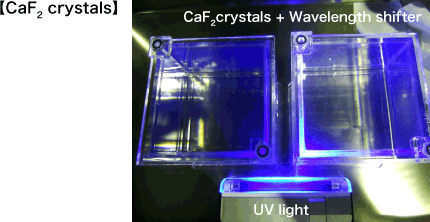
4π direction active shield
The CANDLES detector is uniquely characterized by the structure which the CaF2 crystals are immersed at the center of the liquid scintillator tank. The liquid scintillator acts as a scintillator in the same way as CaF2 crystals do, interacting with radiation to emit scintillation light. As a result, Only scintillation light from CaF2 crystal is emitted as the signal from the neutrinoless double beta decay since all of its energy is deposited inside the CaF2 crystals. On the other hand, two types of scintillation light (or only light from a liquid scintillator) are emitted as the signal from most of background since some (or all) of its energy is deposited in the liquid scintillator. The CANDLES detector uses the same sensor (a large photomultiplier) to observe both the scintillation light emitted by the CaF2 crystals and by the liquid scintillator at the same time. The scintillation light emitted by the CaF2 crystals is distributed approximately 1000 nanoseconds (nsec), while the scintillation light emitted by the liquid scintillator is distributed 100 nsec or less. Therefore it is possible to separate the two signals by observing signal pulse shape. In this way, the CANDLES detector actively blocks out the environmental radiation that enters the CaF2 crystals in the center of the detector, and also the radiation from minute amounts of radioactive impurities contained in the CaF2 crystals, resulting in a powerful reduction in background radiation.
Background-free detector
Owing to the advantage of the high Q value of 48Ca and to improvements in the detection system, the world-leading experiments conducted by our research group involved almost no background noise and achieved the most sensitive measurement of 48Ca double beta decay detection in the world. We have also confirmed that background radiation is not expected as a result of the expansion of detector size that is currently in progress.
Many experiments to search for neutrino-less double beta decay are being carried out amidst fierce competition worldwide.
One of these is the CANDLES experiment. In fact the background has already started to become visible in other experiments. In order to improve the sensitivity of neutrino mass measurement by a factor of 10, it is necessary to increase the lifetime sensitivity by a factor of 100 (due to the relationship between neutrino mass and half-life). To do this, in simple terms it should be sufficient to increase the quantity of decay nuclei by 100 times. However when the non-zero background will be observed, there will be problems with statistical accuracy. In this case, it is necessary to increase the number of nuclei by 10,000 times in order to achieve a 10× increase in sensitivity. If a background-free condition could be performed, it would be possible to achieve a 10× increase in sensitivity with a 100× increase in the quantity of decay nuclei. This is the measuring condition which the CANDLES project seeks to achieve. We believe that of detectors which are currently being planned and proposed, only the CANDLES project is capable of achieving a background-free measurement.
Present and future of the CANDLES project
At present for the CANDLES experiment, a the detector system which uses a 305kg CaF2 scintillators (CANDLES-III Underground) has been installed at the Kamioka underground observatory and is being operated. These observations make maximum use of the advantages gained by the large 4.27MeV Q value of 48Ca, and the initial objective of the project is to prove that a background-free condition is possible using the CANDLES detector.
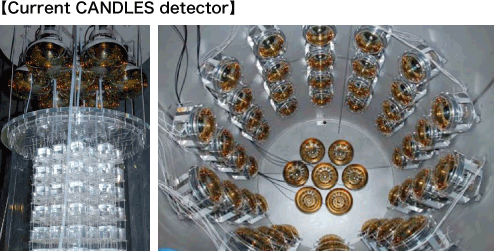
Aiming for higher detector sensitivity, we are working to improve the detector energy resolution , and to concentrate 48Ca in order to increase the amount of decay nuclei and overcome the disadvantage of 48Ca, namely its low 0.2% natural isotope abundance.









